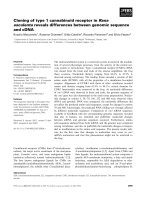Individual Differences and Traits pot
Bạn đang xem bản rút gọn của tài liệu. Xem và tải ngay bản đầy đủ của tài liệu tại đây (2.19 MB, 61 trang )
NGHỆ THUẬT LÃNH ĐẠO
MSMH: NS301DV01 Chapter 3:
Individual Differences
and Traits
Purpose
After studying this chapter, you will be able to:
● Explain the role of individual difference
characteristics in leadership
● Describe the difference between the past and
current approaches to leadership traits
● Discuss the role demographic characteristics play
in leadership
● Identify the impact of values on leadership
● Present the relationship between emotional
intelligence and leadership
● Highlight the role of the “Big Five” and other
personality traits that are relevant in leadership
● Understand cross-cultural differences in individual
difference characteristics
Content
●Elements of individual difference
characteristics
●The demographic characteristics of leaders
●Values
●Abilities and skills
●Relevant personality traits
●Using individual characteristics
Chapter 3
3.1- Elements of
Individual Difference
Characteristics
2 Elements of Individual
Characteristics
● 2 determinants of individual characteristics:
Heredity and Environment
○ Heredity: consist of individuals’ gene pool, gender,
race, end ethnic background.
○ Environment: include physical location, family, culture,
religion, education, and friends.
● Interaction between heredity and environment
○ Environment and social conditions can reinforce
generic patterns to influence a leader’s personality, the
education system, and parental upbringings.
4 Individual Difference
Characteristics
● Demographic factors: such as age, and ethnic
background
● Values: are stable, long-lasting beliefs end
preference about what is worthwhile and desirable
(Rokeach, 1973).
○ Values are closely related to personality. Personality
refers to a person’ character and temperament;
whereas values are principles that a person believes
○ Like personality traits, values guide a leader’s behavior
and are influenced by a combination of biological and
environmental factors (Zaccoro, 2007), values are
shaped early in life and are resistant to change.
○ Values also are influenced heavily by one’s culture.
Individual Difference
Characteristics
● Personality: is a stable set of physical and psychological
characteristics that make each person unique.
● Abilities and Skills:
○ Ability, or aptitude, is a natural talent for doing
something mental or physical, such as intelligence.
○ A skill is an acquired talent that a person develops
related to a specific task.
○ Ability is somewhat stable over time, skills change
with training and experience from one task to another.
○ You cannot train leaders to develop an ability or
aptitude; but you can train them in new leadership
skills. Organizations, therefore, recruit and hire leaders
with certain abilities and aptitudes, and then train them
to acquire needed skills.
Multiple Perspectives and
the Impact of the Situation
● When situations provide little guidance and are
loosely structured, a person’ individual characteristics
can have a strong impact (Barrick and Mount, 1993;
Mischel, 1973; Weiss and Adler, 1984)
● When situations provide strong behavioral cues – that
signal what behaviors and actions are expected and
appropriate – most people behave according to those
cues regardless of their personality traits or other
individual characteristics.
Individual Characteristics
Provide a Range
Each individual characteristic provides a behavioral zone of
comfort.
● The zone of comfort includes a range of behaviors that
come naturally and feel comfortable to perform because
they reflect individual characteristics. Behaving outside of
that zone is difficult, takes practice.
● Although individuals are ease in their behavioral comfort
zone, they learn and grow by moving to zones of
discomfort. The behaviors outside of the comfort zone
challenge them and push them to their limits.
Individual Characteristics
and Behaviors
Leaders’ Individual
Characteristics and Leader
Behaviors
Kirkpatrick and Locke (1991) list a number of traits
that facilitate a leader’s acquisition of needed
leadership skills:
● Drive, which include motivation and energy
● Desire and motivation to lead
● Honesty and integrity
● Self-confidence
● Intelligence
● Knowledge of the business
Leaders’ Individual
Characteristics and Leader
Behaviors
● Some of the traits, namely intelligence and drive, cannot
be acquired through training. Others, such as knowledge
of the industry and self-confidence, can be acquired with
time and appropriate experience.
● The trait of honesty is a simple choice.
● Integrity, or a lack of it, is cited as a key factor in
leadership. Bad leadership contain elements of lack of
trust, dishonesty, and unwillingness to be held
accountable on the part of the leaders.
● Just as some traits are necessary for leadership, they can
be detriment when carried to an extreme.
○ A leader with too much drive may refuse to delegate tasks, and a
desire for too much power can work against a leader’s
effectiveness (Bennis and Nanus, 1985)
Chapter 3
3.2- The Demographic
Characteristics of Leaders
Homogeneity
Homogeneity of the executives
● Although education opens the door for diverse people to
reach leadership positions, and although there has been
progress in the number of women and people of diverse
nationalities in leadership positions, the leadership path is
still primary influenced by birthplace, nationality,
religion, education, social class, gender, and race
(Mayo and Nohria, 2006)
● Formal organizational leadership is still heavily dominated
by males.
Homogeneity
● Homogeneity in demographic background
does not necessarily lead to similar approaches
in managing a business and leading followers;
but to lead to high diversity of thought and
approaches to management.
● Homogeneity can be a strength if unity of
purpose is needed, it can be a weakness where
creativity is required lack of innovative
management approaches.
Chapter 3
3.3- Values
Values
● Values are long-lasting beliefs about what is
worthwhile and desirable. They are personal
judgments about what is right and wrong, good
and bad.
Value System and Culture
● The ways in which a person organizes and prioritizes
values is that person’s value system.
● Each individual’s value system is unique.
● Many factors influence what an individual’s values are:
gender and cultural differences in values (Golob and
Bartlett, 2007; Schwartz, 2005)
○ Women place a higher value on family and social issues,
whereas men focus more on economic problems.
○ Individualism is typically highly valued in industrialized Western
countries, whereas collectivism is a dominant value in many
Eastern cultures.
○ Cultural values indicate what a cultural group considers important,
worthwhile, and desirable. The cultural values form the basis for a
leader's individual value system.
○ Certain values – fairness, honesty, frugality, compassion, and
humility – are universal.
○ Whereas in individualistic cultures, the uniqueness, self-control,
and self-governance are prevalent.
Chapter 3
3.4- Abilities and
Skills
Intelligence
● Traditional definition of intelligence: cognitive ability to
remember, collect, and integrate information, analyze
problems, develop solutions, and evaluate alternatives.
○ For most people, intelligence is a factor in leadership;
however, actual link between intelligence and
effectiveness is far from clear (Rubin, Bartens, and
Bommer, 2002)
● To date, only one leadership theory, the Cognitive
Resource Model (Fiedler and Garcia, 1987a, b) has used
intelligence as a factor.
○ When being competent is important, leaders who are
more intelligent may do better, but in situations that
require interpersonal skills, general intelligence may not
be sufficient.
Practical Intelligence
● Practical Intelligence: being able to work well with
others or having the skills needed to succeed in life
types of skills and attributes that people use to solve
everyday challenges they may face.
○ People with this type of intelligence either change their
behavior to adapt to the environment, manipulate the
environment, or find a new environment (Sternberg et
al., 2000)
○ WICS model of leadership – integrates Wisdom,
Intelligence, and Creativity in a System approach
putting intelligence at the center of leadership traits
(Sternberg 2003)
Emotional Intelligence
● Emotional Intelligence (EI; or EQ for Emotional
Quotient): the ability to interact well with
followers, satisfy their emotional needs, and
motivate and inspire them social and
interpersonal aspects of intelligence.
Components of Emotional
Intelligence
Component Description
Self-
awareness
Being aware of and in touch with your own
feelings and emotions
Self-regulation Being able to manage various emotions and
moods without denying or suppressing them
Self-motivation Being able to remain positive and optimistic
Empathy for
others
Being able to read others’ emotions
accurately and putting yourself in their place
Interpersonal
and social
skills
Having the skills to build and maintain
positive relationship with others









